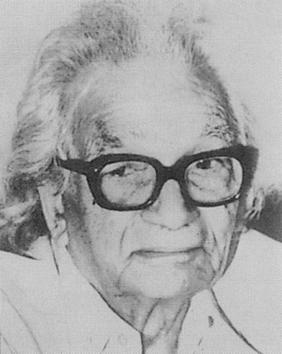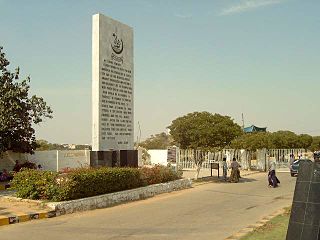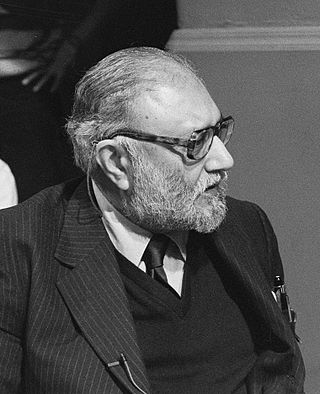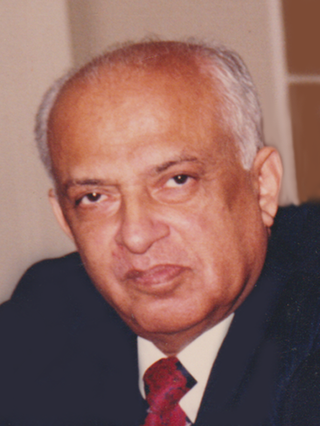Related Research Articles

The University of Karachi is a public research university located in Karachi, Sindh, Pakistan. Established in June 1951 by an act of Parliament and as a successor to the University of Sindh, the university is a "Sindh Government University" and designed by Mohsin Baig as its chief architect.
The Royal Australian Chemical Institute (RACI) is both the qualifying body in Australia for professional chemists and a learned society promoting the science and practice of chemistry in all its branches. The RACI hosts conferences, seminars and workshops. It is the professional body for chemistry in Australia, with the ability to award the status of Chartered Chemist (CChem) to suitably qualified candidates.

Salimuzzaman Siddiqui, was a Pakistani organic chemist specialising in natural products, and a professor of chemistry at the University of Karachi.

The International Center for Chemical and Biological Sciences (ICCBS), also known as the Hussain Ebrahim Jamal Research Institute of Chemistry and Dr Panjwani for Molecular Medicine and Drug Research, is a federally funded national research institute managed by the University of Karachi.

Atta-ur-Rahman, is a Pakistani organic chemist and is currently serving as Professor Emeritus at the International Center for Chemical and Biological Sciences at the University of Karachi and as Chairman of PM Task Force on Science and Technology. He has twice served as the President of Pakistan Academy of Sciences. He was the Federal Minister of Science and Technology (2000-2002), Federal Minister of Education (2002) and Chairman Higher Education Commission with status of Federal Minister (2002-2008) He is also the President of the Network of Academies of Sciences in Countries of the Organisation of Islamic Countries (NASIC). After returning to Pakistan from Cambridge after completing his tenure as Fellow of Kings College, Cambridge University, he contributed to the development of the International Center for Chemical and Biological Sciences at the University of Karachi, and transforming the landscape of higher education, science and technology of Pakistan. He is Fellow of Royal Society (London), Life Fellow of Kings College, Cambridge University, UK.,, Academician Chinese Academy of Sciences and Professor Emeritus at University of Karachi

The Pakistan Academy of Sciences, is a learned society of sciences, which described itself as "a repository of the highest scientific talent available in the country."

Science and technology have been pivotal in Pakistan's development since its inception. The country boasts a large pool of scientists, engineers, doctors, and technicians actively contributing to these fields.
Khalil Ahmad Qureshi, is a Pakistani physical chemist and the professor of physical chemistry at the Punjab University. He has published notable papers in nuclear physical chemistry in international scientific journals as well contributing in the advancement of the scientific applications of the civilian usage of the fuel cycle.
Iqbal Hussain Qureshi 27 September 1937 – 8 December 2012) SI, FPAS, best known as I.H. Qureshi, was a Pakistani nuclear chemist and an Emeritus professor of chemistry at the University of Karachi. Qureshi was the principal contributor of scientific understanding of various chemical elements: bismuth, cobalt, strontium, thallium, tritium, iron, rubidium, and zinc.
Muhammad Iqbal Choudhary is a scientist in the field of organic chemistry from Pakistan. He is known for his research in various areas relating to natural product chemistry. He has more than 800 research publications. In 2015 he was recognised as the second most productive scientist in Pakistan.
Goverdhan Mehta is an Indian researcher and scientist. From 1998-2005 he was the director of the Indian Institute of Science (IISc). Previously from 1977-1998, Mehta was a professor of chemistry and vice-chancellor at the University of Hyderabad. Mehta has authored over 550 research papers.
Jai Pal Mittal is an Indian scientist, DAE Raja Ramanna Fellow of Bhabha Atomic Research Centre and Distinguished Professor of Indian Institute of Technology, Mumbai, the National Academy of Sciences, India and the University of Pune. He is known for his researches in the fields of photochemistry and radiation chemistry. He was honoured by the Government of India in 2003 with Padma Shri, the fourth highest Indian civilian award.

Ganapati Dadasaheb Yadav is an Indian chemical engineer, inventor and academic, known for his research on nanomaterials, gas absorption with chemical reaction and phase transfer catalysis. He served as the vice chancellor of the Institute of Chemical Technology, Mumbai from 2009 until November 2019. He is currently the Emeritus Professor of Eminence at ICT Mumbai.
Sadhan Basu FNA, FASc, FRSC was an Indian physical chemist, academic and the Palit Professor of Chemistry at the University of Calcutta from 1964 to 1985. He was known for his elucidation of the Quantum Mechanical Model of Robert S. Mulliken. His article, Degree of Polymerization and Chain Transfer in Methyl Methacrylate, co-authored with Jyotirindra Nath Sen and Santi R. Palit was the first published Indian article on polymer chemistry. He was an elected fellow of the Royal Society of Chemistry, Chemical Society of France, Indian Chemical Society, Indian National Science Academy and the Indian Academy of Sciences. The Council of Scientific and Industrial Research, the apex agency of the Government of India for scientific research, awarded him the Shanti Swarup Bhatnagar Prize for Science and Technology, one of the highest Indian science awards, in 1962, for his contributions to chemical sciences.
Hirdaya Behari Mathur was an Indian physical chemist and the director of Defence Materials and Stores Research and Development Establishment, Kanpur. He was known for his studies on radioactive isotopes and solid state diffusion of metals. Mathur was a fellow of Sigma Xi and an elected fellow of the Indian National Science Academy and the Indian Academy of Sciences. The Council of Scientific and Industrial Research, the apex agency of the Government of India for scientific research, awarded him the Shanti Swarup Bhatnagar Prize for Science and Technology, one of the highest Indian science awards, in 1973, for his contributions to chemical sciences.
Swapan Kumar Pati is an Indian quantum chemist, a professor of the department of chemistry at the Jawaharlal Nehru Centre for Advanced Scientific Research and the head of the Quantum Theory Molecules to Materials Group at the institute. He is known for his studies on electronic optical and magnetic phenomena in molecular systems and is an elected fellow of the Indian Academy of Sciences, National Academy of Sciences, India and The World Academy of Sciences. The Council of Scientific and Industrial Research, the apex agency of the Government of India for scientific research, awarded him the Shanti Swarup Bhatnagar Prize for Science and Technology, one of the highest Indian science awards, in 2010, for his contributions to chemical sciences.
Govindasamy Mugesh is an Indian inorganic and physical chemist, a professor and the head of the Mugesh Laboratory attached to the department of Inorganic and Physical Chemistry at the Indian Institute of Science. He is known for his studies on the mechanism of thyroid hormone action and is an elected fellow of the Indian Academy of Sciences, Indian National Science Academy, Royal Society of Chemistry and the National Academy of Sciences, India. The Council of Scientific and Industrial Research, the apex agency of the Government of India for scientific research, awarded him the Shanti Swarup Bhatnagar Prize for Science and Technology, one of the highest Indian science awards, in 2012, for his contributions to chemical sciences. In 2019, he was awarded the Infosys Prize in Physical Sciences for his seminal work in the chemical synthesis of small molecules and nanomaterials for biomedical applications.

Mumtaz Ali Kazi, popularly known as M.A. Kazi, was one of Pakistan's leading scientists and educators. He was President of the Pakistan Academy of Sciences from 1978 to 1988 and President of the Chemical Society of Pakistan from 1977 to 1990.

Irshad Hussain is a Pakistani scientist in the field of chemistry and among the few pioneers to initiate nanomaterials research in Pakistan.
Bina Shaheen Siddiqui is a Pakistani chemist and the Director of the H.E.J. Research Institute of Chemistry at the University of Karachi. Siddiqui graduated from the University of Karachi with an MPhil in 1978. In 1980, she graduated from the same university with a PhD in organic chemistry.
References
- ↑ FACS. "FACS:Chemical Society of Pakistan". Press release of the Federation of Asian Chemical Societies. Federation of Asian Chemical Societies. Retrieved 17 January 2012.
- 1 2 3 4 CSP, Chemical Society of Pakistan. "History of Chemical Society of Pakistan". History of Chemical Society of Pakistan. Archived from the original on 21 March 2012. Retrieved 17 January 2012.
- 1 2 3 4 FPAS. "Fellows of the Pakistan Academy of Sciences". Pakistan Academy of Sciences. Directorate-General of the Public Relations of Pakistan Academy of Sciences. Archived from the original on 11 January 2012. Retrieved 17 January 2012.
- ↑ "Bina Shaheen Siddiqui".